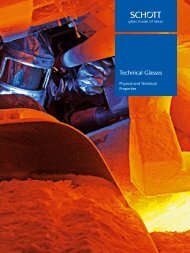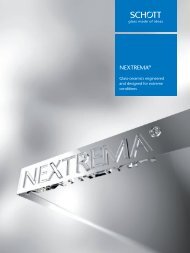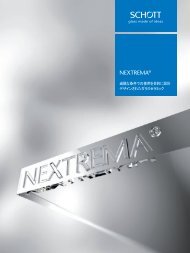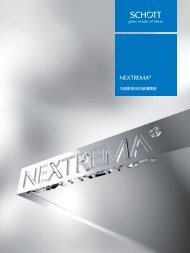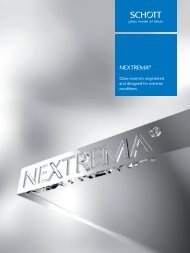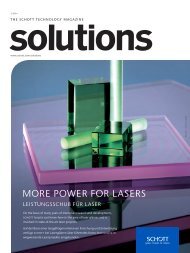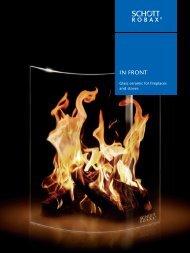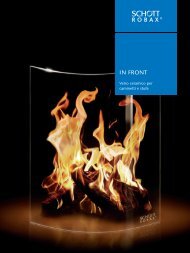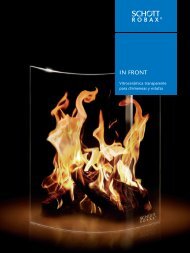Technology Magazine "SCHOTT solutions" - Edition 2/2013 - Technologie Magazin "SCHOTT solutions"
A variety of SCHOTT innovations The latest issue of our technology magazine “solutions” discusses innovations our SCHOTT experts are developing, how they provide support for our customers as partners and how they are addressing tomorrow’s challenges today. Our broad range of products and materials opens up a wide variety of different topics ranging from the universe all the way to the nano cosmos. We wish you enjoyable reading! Spannende Stories über SCHOTT Innovationen Die neuste Ausgabe des Technologiemagazins „solutions“ verrät, was SCHOTT Experten entwickeln, wie sie Anwendern kompetenter Partner sind und die Herausforderungen von morgen schon heute anpacken. Unsere breite Produkt- und Materialpalette erschließt dabei ein weites Feld: vom Weltall bis in den Nanokosmos. Viel Spaß beim Lesen!
A variety of SCHOTT innovations
The latest issue of our technology magazine “solutions” discusses innovations our SCHOTT experts are developing, how they provide support for our customers as partners and how they are addressing tomorrow’s challenges today. Our broad range of products and materials opens up a wide variety of different topics ranging from the universe all the way to the nano cosmos. We wish you enjoyable reading!
Spannende Stories über SCHOTT Innovationen
Die neuste Ausgabe des Technologiemagazins „solutions“ verrät, was SCHOTT Experten entwickeln, wie sie Anwendern kompetenter Partner sind und die Herausforderungen von morgen schon heute anpacken. Unsere breite Produkt- und Materialpalette erschließt dabei ein weites Feld: vom Weltall bis in den Nanokosmos. Viel Spaß beim Lesen!
You also want an ePaper? Increase the reach of your titles
YUMPU automatically turns print PDFs into web optimized ePapers that Google loves.
The scanning electron microscope Neon 40 helps <strong>SCHOTT</strong><br />
researchers to find answers to difficult questions on developmental<br />
and damage analysis more quickly. The photos to the<br />
right show how a sample is placed inside the system.<br />
Mit dem Rasterelektronenmikroskop Neon 40 können <strong>SCHOTT</strong><br />
Forscher komplexe Fragen der Entwicklungs- oder Schadensanalytik<br />
nun schneller beantworten. Die Bilder rechts zeigen<br />
das Einbauen einer Probe.<br />
Photos Fotos : schott/ C. Costard<br />
(FIB) optics that are aligned diagonally to the electron beam also<br />
allow for preparation of the smallest surface structures by scraping<br />
off small amounts of material. Cuts through or exposure of material<br />
surfaces are possible down to the nano level with the FIB.<br />
In fact, they can be examined and prepared at the same time with<br />
the SEM and the FIB.<br />
A mixed type – such as brittle, porous glass embedded in a<br />
ductile (plastically preformed) polymer matrix – could never be<br />
processed using traditional techniques such as grinding, polishing,<br />
breaking or cutting, without destroying or altering the material<br />
structure. For use in innovative rechargeable batteries, the goal is<br />
to manufacture the separator material to be as thin as possible.<br />
After all, the thinner the foil, the higher the energy density of the<br />
battery. At the same time, however, its mechanical, chemical and<br />
temperature stability needs to be maintained. Here, the Neon 40<br />
helps us learn more about surface structures in order to ultimately<br />
be able to improve them, by determining the right degree of<br />
porosity of a material, for example. “Our research and development<br />
is in need of clear images and information on materials and<br />
structures that we can work with. Otherwise, we won’t be able to<br />
Die diagonal zum Elektronenstrahl ausgerichtete Ionenstrahloptik<br />
FIB (Focused Ion Beam) ermöglicht auch die Präparation<br />
kleinster Oberflächenstrukturen durch Abtragen winzigster Materialmengen.<br />
Schnitte durch oder Freilegen von Werkstoffoberflächen,<br />
das gelingt mit FIB bis auf Nano-Ebene. Dabei lässt sich<br />
mit SEM und FIB gleichzeitig beobachten und präparieren.<br />
Selbst kombinierte Materialien wie das erwähnte Beispiel bereiten<br />
keine Probleme: Sprödes, poröses Glas, eingebettet in eine<br />
duktile (plastisch verformbare) Polymermatrix – ein solcher Mix<br />
wäre mit klassischen Verfahren wie Schleifen, Polieren, Brechen<br />
oder Schneiden nicht zu bearbeiten, ohne das Materialgefüge zu<br />
zerstören oder zu verändern. Dieses Separatormaterial für innovative<br />
wiederaufladbare Batterien soll möglichst dünn hergestellt<br />
werden. Denn je dünner diese Folie, desto höher die Energiedichte<br />
des Akkus. Zugleich darf aber ihre mechanische, chemische und<br />
Temperatur-Stabilität nicht leiden. Hier trägt das Neon 40 dazu<br />
bei, Oberflächenstrukturen genau kennenzulernen, um diese letztlich<br />
optimieren zu können – zum Beispiel mit der Bestimmung<br />
einer passenden Porositätsgröße des Materials. „Unsere Forschung<br />
und Entwicklung braucht klare Bilder und Aussagen über die<br />
11






